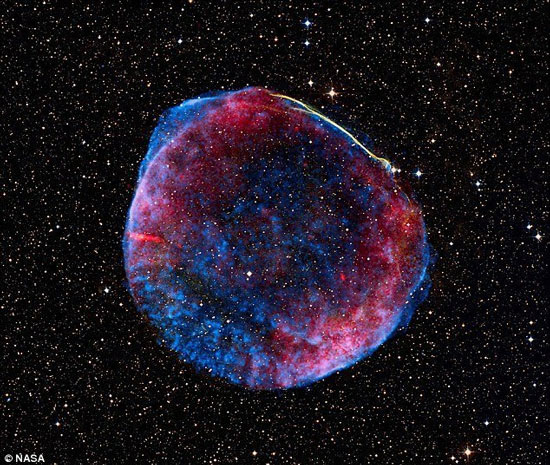The lonely death of a star
In 1006, the whole world stalled and stared up at the sky when a giant star 7,000 light-years away 'from the last breath of Earth ' , exploded to illuminate the entire galaxy.
>>>Video: The lonely death of a star
Supernova SN-1006 was seen around the world that year, lighting up the sky with such intensity that it could be read in the middle of the night. However, scientists today discover that this star is a loner, the Daily Mail said.
Many supernovae, the stellar explosions that make up very bright objects mainly consist of plasma that bursts in a short time, occur when two stars collide with each other or at least close enough to break the structure of together. And the death of SN-1006 seems to be done by itself.

The capture of SN 1006 supernova was captured by NASA.
Seeing supernovae is rarely recorded in human history, but each time it appears to be confusing or warning something to people in that era.
Old sky observers often gave very detailed descriptions of this phenomenon. For example, Egyptian astronomer Ali ibn Ridwan noted the appearance of SN-1006 near the southern horizon, which is round, 2.5 to 3 times larger than Venus. He said the sky was bright with a bright intensity equal to a quarter of the moon's light.
Meanwhile, Benedictine monks belong to St. Vincent's monastery, Switzerland, describing this object sometimes shrinking, sometimes expanding and sometimes eclipsing.
Today, astronomers at the Paranal Observatory in Chile have looked around the supernova SN-1006 and no longer find any stars or their ruins within 16.5 light years. .
Perhaps this giant star has collapsed because of its own gravity. In just a few seconds, most of the stars have undergone fusion and explosion reactions, with the intensity of light emitted more than billions of times that of the Sun, creating enough power to blow away the inner shell. outside the star at a speed of 4% of the speed of light.
- The scientists were skeptical of discovering Star Death
- Find the most 'lonely and poor' planet in the universe
- The 'lonely star' was kicked out of the Milky Way, forever in nothingness
- Witness the giant star's death
- Unexpectedly, the most remote, lonely neutron star in the universe
- The most lonely bird on the planet is dead
- What is the most lonely human being?
- Just a bite from this tiny beetle, you won't be able to eat meat forever
- Close up of a star's death
- Mysterious giant star on the surface of the Earth
- 8 countries 'most lonely' in the world
- The 'dead' sun will look like this
 Van Allen's belt and evidence that the Apollo 11 mission to the Moon was myth
Van Allen's belt and evidence that the Apollo 11 mission to the Moon was myth The levels of civilization in the universe (Kardashev scale)
The levels of civilization in the universe (Kardashev scale) Today Mars, the sun and the Earth are aligned
Today Mars, the sun and the Earth are aligned The Amazon owner announced a secret plan to build a space base for thousands of people
The Amazon owner announced a secret plan to build a space base for thousands of people